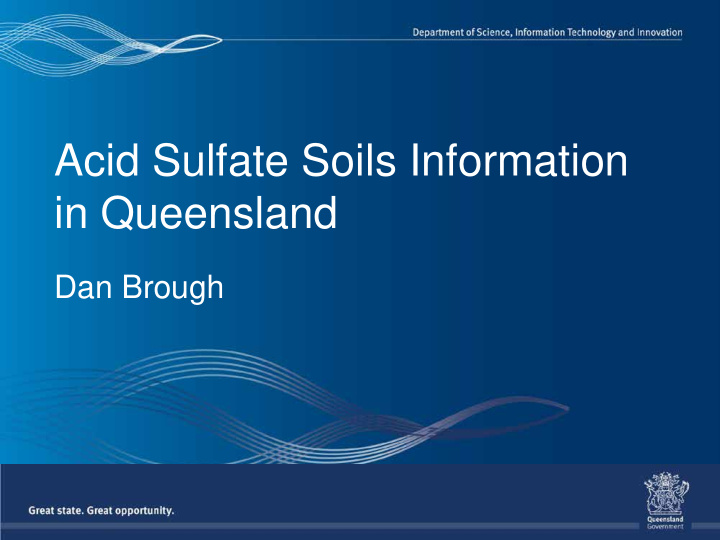



Acid Sulfate Soils Information in Queensland Dan Brough
Outline • ASS Soil Management Guideline v4.0 • National Guidance Material • Online Data and Resources
Soil Management Guideline • What’s new? – New ASS Tips and case studies – New methodologies for treatment – Closure Reporting – More consistent wording, flow improvements
Chapter 1 • Terminology • AASS/PASS as a spectrum, not a binary • Distinction between natural oxidation processes and the effects of human disturbance • MBOs
Tip – MBOs • Rapid formation under the right conditions
Tips – ASS and infrastructure • Concrete – sulfate as well as acid vulnerability • Location/placement of infrastructure in the environment • Effects on metal pipes including bacterial attack
Case Study – Peat with Pyrite • Not all ASS is mangrove mud! • Effects of urbanisation, domestic dewatering • High-organic sediments • Health effects
Chapter 4 • Mostly cosmetic changes • Action criteria are the same – Draft criteria for poorly-buffered sands • Effect of cumulative disturbances • Risk and treatment categories – Management plan complexity appropriate to disturbance
Chapter 6 • Less emphasis on specific legislation • Vulnerable environments – Groundwater-dependant ecosystems – Sensitive wildlife – Algal blooms
Chapter 7 • New ways to minimise disturbance – Dewatering confinement technologies – Alternatives to open trenching – Drain/floodplain management – Compression and filling – Piles/foundation design
Chapter 8 • New Tip – Lime ain’t lime • Verification Testing rates – Not set in stone – adaptable to site – Principles for setting rates – Allowance for short-range variation in mixing efficiency – Mention of international standards for sampling
Chapter 8 • Example methods for verification testing – Demonstration of sampling principles • Alternative neutralising materials • New Tip: Application rate calculation • New Tip: Limitations of in situ neutralising material
Chapter 8 • New Tip - Off-site treatment • Use of pug mills/soil mixers • Dealing with wastes from treatment areas • New Tip – Uses for treated ASS
Small Volume Disturbances • Mostly for local/state government installing small infrastructure or doing maintenance • Rates determined from lab data stored in Qld Soil and Land Information System • Inherent risk of overtreatment if used on large volumes of soil
Non-ASS Acidic Soils • Restricted to soils in ASS terrains • Origin of acidity less important than risk – Volume and type of disturbance – Other leachates e.g. aluminium, iron
Non-ASS Acidic Soils • Management =/= full treatment – Spot liming – guard layers – leachate management – monitoring
Chapters 11-12 • Medium- and long-term stockpiling rates removed
Chapter 13 • Closure Reports – Documentation of what actually happened – Learning opportunity – Provides information relevant to future use – Provides reassurance to stakeholders – Informs remediation if something goes wrong • Ideally form-based for most projects
Handover Testing • Option for large, extensive projects only • Residential subdivisions, canal estates, made land • Works where normal verification testing methods are difficult to apply • Confirmation of effective treatment in the top 1.5m – Most likely to be re-disturbed
Handover Testing • Use of independent third parties • Boreholes across final surface – 0.5m bulked samples – No need for high-detail soil description • Performance criteria designed allow for minor exceedances but not systematic treatment failure • Addendum to usual closure reports
National Guidance Material • Coming soon – MBOs – ASS and Dredging – ASS, Groundwater and dewatering – Methods Manual
Queensland Information Resources • The Soils Globe! – Google Earth display of soil data – ASS (and other soil) mapping – 90,000 soil sites • Open Data – Data.qld.gov.au – Publically available soil data – Consistent format
Web resources • www.qld.gov.au/soils – The resource for Queensland Government soil information – Links to all our resources and sources of further information
Recommend
More recommend